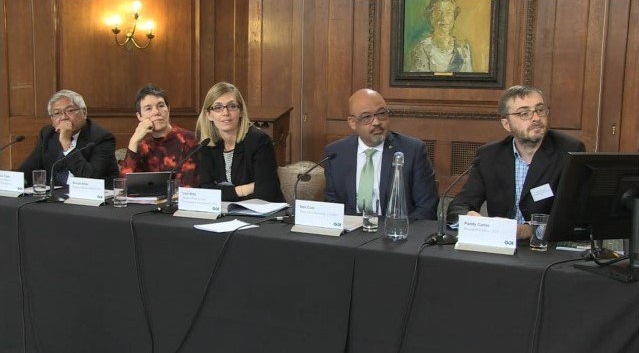
Neil Cole and Joana Bento from the CABRI Secretariat participated in the 2016 Conference on Aid and Public Expenditure (CAPE) in London on 19 and 20 October. The CAPE event is held annually by the Overseas Development Institute and attracts public officials, academics, and development experts from all over the world. This year’s conference was framed as a consensus building exercise on ways that development assistance (aid) can be delivered more effectively in the era of the Sustainable Development Goals. The conference theme was chosen to coincide with the Nairobi 2nd High Level Meeting on Development Effectiveness.
CABRI’s contribution at the London conference focussed on the progress that has been made by development partners (donors) in their use of country systems in the delivery of aid, and ways that even greater progress can be made. Below is an extract of CABRI’s contribution.
Several international agreements call on donors to use country systems to the maximum extent possible. These agreements acknowledge that when countries’ own systems are used there is a potential pay-off of increased investment in strengthening these systems.
Various assessments, including studies undertaken by CABRI, reveal a weak correlation between the strength of country systems and the extent to which development partners use these systems for the delivery of aid. There also appears to be a threshold effect where development partners reach a level of use of country systems and do not move from that level, irrespective of an improvement or deterioration in the quality of the country systems.
We believe that there are several reasons for this.
Global agreements on aid effectiveness have all included a commitment for an increase in the use of country systems for the delivery of aid. The more recent Busan Partnership Agreement includes a commitment under paragraph 19(b) that states “where the full use of country systems is not possible, the provider of development co-operation will state the reasons for non-use, and will discuss with government what would be required to move towards full use, including any necessary assistance or changes for the strengthening of systems”. While this has focussed attention on the approach that will be used when considering the extent that country systems can be used, it has also led to an all or nothing approach and a too narrow link between an increase use of country systems and the provision of budget support. Budget support is a mode of delivering aid where a development partners gives aid directly to the recipient government. Unfortunately, budget support is often equated with the global commitments on UCS. Where development partners are unable to provide budget support as a mode of delivering aid, it is seen as a failure to honour the global commitments to increase the use of country systems.
Budget support is an aid modality. The commitment to increase the use of country systems is a principle that commits development partners to use the systems of a country for the delivery of aid, irrespective of the aid modality that is in place.
We should think of country systems not as one system, but as separate components (diagram 1). The eight components are typically the ones that are used for the strategic allocation, disbursement, and accounting for government revenue.

Diagram 1: Country systems
Where country systems are not used, either in its entirety or just one or more of the components in diagram 1, donors will establish parallel systems that they have full control over, especially in the procurement of goods and services. It is important to acknowledge that the fiduciary risks differ across each of the eight components. For instance, including all aid on the plan and budget process carries far less fiduciary risks for donors than their use of the local procurement systems for the delivery of aid funded projects.
It is useful for the high-level forum on development effectiveness in Nairobi to distinguish the individual components, instead of referring in general terms to use of country systems. This is important because the commitment to “full use of country systems” is biased towards budget support, which is a political instrument that not all donors can commit to.
CABRI calls for all aid to be:
- On-plan and on-budget – development partners should ensure that information on all aid is timeously shared with recipient countries as a forecast of the estimated revenue for allocation through the budget process.
- On-parliament – if progress is made in fully integrating all aid information on plan and on budget, all aid revenue to be received by a government can be included in the budget documents presented to Parliament. This enables greater accountability and legislative oversight of expenditure.
The remaining components, such on-procurement and on-audit carries a higher fiduciary risk. Joint assessments at a country-level should determine the state of these systems and agree on the actions that are needed and timeframes for their use.
In conclusion, when making decisions about the systems that can be used, attention must also be paid to the long-term developmental risks of not using country systems. Understandably, donors will be hesitant because they forfeit some degree of control over their development assistance, which can be perceived to increase the risk of activities not being implemented or of funds not being used as intended. These risks are short-term and donor-specific. The benefits of using country systems, however, are developmental and long-term.